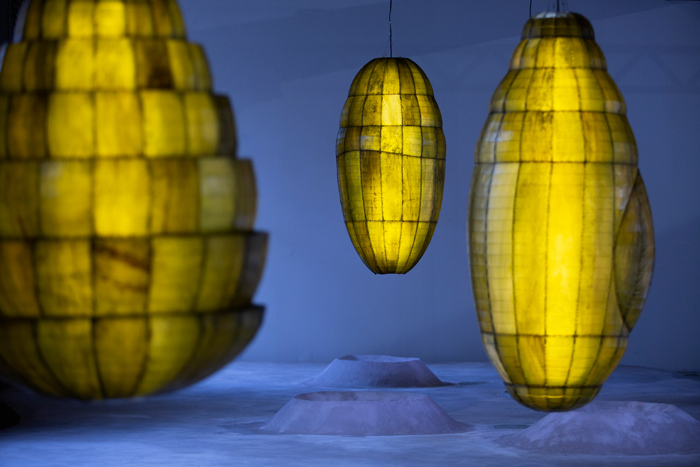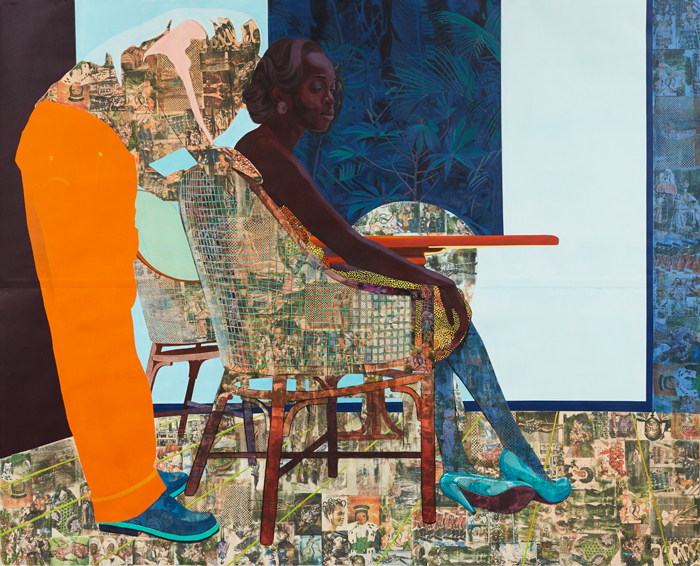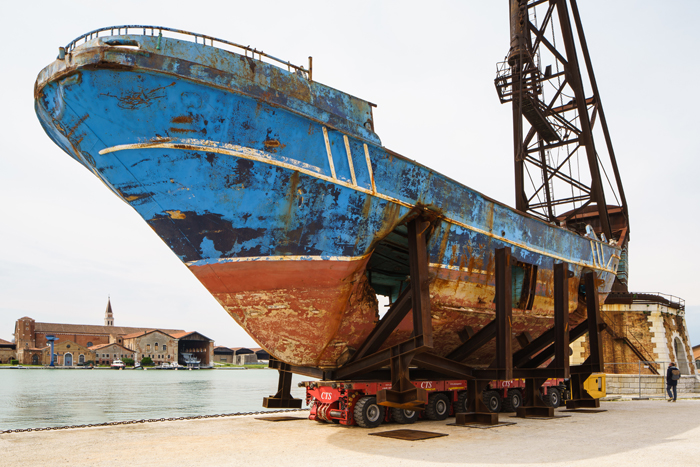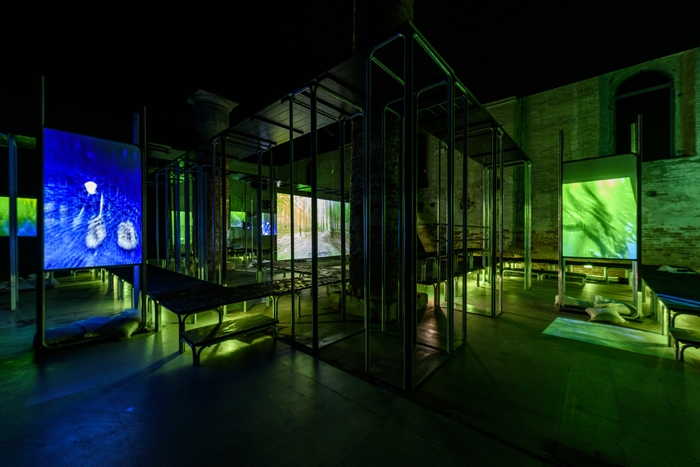That Ralph Rugoff has taken for his title a Chinese curse fabricated by Western scholars to reinforce a caricature of the East might be interpreted as a warning: don’t trust everything you read; beware binary narratives; remember that identity is a cultural construct. To illustrate the point, he has produced the ‘same’ exhibition twice, with twin displays at the Arsenale (‘Proposition A’) and in the Giardini (‘Proposition B’) showing different works by the same 79 living artists.
The use of the equivocal ‘proposition’ (as opposed to, say, ‘concept’ or even ‘exhibition’) implies an experiment in using the same sources to construct divergent narratives. So while ‘Proposition A’ opens with Antoine Catala’s soothing grid of pastel-coloured platitudes It’s Over, visitors to the Arsenale are greeted by George Condo’s vast and violent Double Elvis (both works 2019). The hope seems to be that these antagonisms will disrupt fixed ways of thinking, and that new ideas might emerge from the contest.
‘Proposition B’ seems primed to represent the dark side: the aggression of Condo’s mirrored portrait of two gigantic bottleclutching bums is exaggerated by the unpainted plywood walls on which it hangs, lending the artworld’s most prestigious showcase the impression of having been knocked together from packing crates. Yet, in the first of many jarring juxtapositions, this brutish painting is shown beside the work of Zanele Muholi and Soham Gupta, whose documentary photographs of marginalised individuals in, respectively, South Africa and India speak to an altogether more empathic vision of art as instrument of social justice. A discombobulating opening is completed by Christian Marclay’s crash-bang-wallop video installation, which tiles 48 War Movies (2019) into a concentric rectangular mise-en-abyme soundtracked by the racket of overlaid screams and explosions.

These discordant arrangements don’t necessarily pay off. As Marclay’s spectacle mistakes incoherence for polyphony, so nuance is often drowned out by contributions that seem to play with horror for the cheap satisfaction of rubbernecking passersby (most notably in Sun Yuan and Peng Yu’s schlocky contributions to both venues, including a giant robotic arm that frantically mops up a spreading pool of viscous red liquid). Yet the strongest works in this startlingly uneven exhibition use dissonance to their advantage. Montaging YouTube posts, music videos and CCTV footage, Arthur Jafa’s Golden Lion-winning 50-minute video mix tells a subaltern history of white identity. By cutting rapidly between its source materials, The White Album (2018) collapses the viewer’s knee-jerk responses to different stimuli – white people passionately denouncing white supremacism, concealing automatic weapons on their person, being beaten to the ground by young men of colour, failing to recognise their own privilege – into an emotional experience that is both coherent and complex. Which is to say humane.
The work may not be new – a large proportion of the works exhibited here, and most notably those hailing from China and Africa, will be familiar to anyone who has recently passed through the world’s major commercial galleries and institutions – but Jafa is also one of the few artists effectively to exploit the invitation to work across two spaces. A series of monumental sculptures in the Arsenale simultaneously alludes, by draping vast automotive parts in metal chains, to the decline of Midwestern industry, the historical abuse of shackled black bodies and the mass incarceration of the black men who might once have been employed by General Motors or US Steel. It’s a reminder that the ‘managed decline’ of the industrial heartlands had consequences for demographics beyond the white working class whose sense of abandonment is so often cited in accounts of the rise of Trump, and in combination with The White Album (on show in the Giardini), it might cause the viewer to question why that reading has become such a commonplace on both sides of the aisle. These counternarratives – also given a platform in Kahlil Joseph’s proposal for a television channel, BLKNWS (2019) – catalyse the kind of independent and intersectional thinking that one imagines Rugoff was hoping to encourage.
This reluctance to tie up its many loose ends is at once a strength and weakness of the exhibition, and to introduce so many different ideas, but follow up so few, will frustrate those who prefer an exhibition to develop a treatise rather than unleash cacophony. The abrupt shifts of register are too often disadvantageous to individual works, and so the paintings of Njideka Akunyili Crosby and Henry Taylor in the Arsenale, for instance, are unfairly diminished by the makeshift exhibition design and the unrelenting visual noise. Anicka Yi and Ian Cheng’s compelling experiments in alternative intelligence and systems thinking, meanwhile, seem out of step with the prevailing tendency towards disparity and fragmentation. But that Rugoff has created an environment which is rarely conducive to the disinterested aesthetic contemplation of a work of art strikes me as the point: the constant interruptions to the visitor’s trains of thought are surely intended to be disruptive of any single interpretation of what the exhibition – and by extension what the art of today – should mean.


So the vaunted autonomy of high-modernist form seems everywhere to have been corrupted, from Lee Bul’s latticed metal transmission tower to Carol Bove’s twisting and crumpling of the implacable forms and immaculate materials of American minimalism. The title of Lee’s work (Aubade V, 2019) shares a sense of disillusion with Philip Larkin’s poem of the same name, specifically its celebrated characterisation of organised religion as ‘That vast moth-eaten musical brocade / Created to pretend we never die’, a couplet that might also serve to critique the kind of art that pretends to stand entirely outside of its time and place. Most powerfully, the status of Teresa Margolles’s triptych of standing glass sheets as forms abstracted from life but independent of it (one definition of art) is psychologically undercut by the notices for missing women in Mexico’s Ciudad Juárez with which they are stickered, and physically threatened by the subterranean mechanical rumble that rattles the panes against their frames.
By attending carefully to the effect of her installation on the senses, Margolles generates a physical discomfort that feels appropriate to such freighted objects. Her achievement in doing so is thrown into sharp relief by Christoph Büchel’s installation of a holed boat in which hundreds died when attempting to reach Europe from Libya. Not part of Rugoff’s main exhibition, the work is crass not because it upsets liberal pieties but because it reinforces them. Unobtrusively installed beside a dockside café and provided with no supporting information, it appears designed to lure unsuspecting passersby into taking selfies beside it so that those who got the artworld memo could chastise those who didn’t.

The impression of the hermetic seal separating art from the world having been broken, and the contents spoiled, is much more deftly staged in Ed Atkins’s Old Food (2017) in the Arsenale. It features a series of darkly funny digital animations that, like Alex Da Corte’s equally dreamlike if cheerier video installation Rubber Pencil Devil (2018), takes a perverse delight in art’s freedom from the responsibility of redemptive meaning. This liberating disenchantment – which shouldn’t be mistaken for disengagement – also shines through Nicole Eisenman’s Achilles Heel (2014), which will chime with anyone suspicious of the innate grandiosity of the biennale format or statements like Büchel’s. A painting reminiscent of Philip Guston’s late work depicts a man sitting at a dimly lit bar poking at a malleable lump of wax or clay, putting forward a vision of what it means to make art far removed from the glamorous vapidity and righteous proselytising that mark the two ends of the artworld’s wide spectrum of beliefs and attitudes.
Another of those in-between spaces is the subject of Hito Steyerl’s This is the Future (2019). A playful reminder of the limits to human and artificial intelligence, the multiscreen installation marries images of budding flowers generated by an artificial neural network to a narrative that warns against presuming to predict the future, however sophisticated the algorithm, comprehensive the data set or objective the intellectual framework. As the interface between past and future, the present joins what we know to what we don’t. Which is as good a definition of the purpose of art as I found amidst this alternately entertaining and infuriating mess of an exhibition.
May You Live in Interesting Times, The International Exhibition, Venice Biennale, 11 May – 24 November 2019
From the Summer 2019 issue of ArtReview
